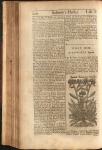Also see Chap. 072. Birds-Eye. - Chap. 157. Of Cowslips. - Chap. 158. Of Cowslip Spotted.
This chapter hasn't been proofread yet.
I. The Names. It does not appear that this X Plant was known to the Greeks, yet fome, as accounting it among the Kinds of Comfrey, have called it xu^tmv l^mSi: It is called in Latin, Pul-monaria, (and yet it is no Species of the Lungworts, as we shall, God willing, hereafter shew:) also, Symphitum maculosum : and in English, Jerusalem Cowslip, and Spotted Cowslip, ( and yet it is not of the Species οÎ_ Cowslips:) also Sage of Jerusalem, Sage of Bethlem, Spotted Lungwort, and
Spotted Comfrey.
II. The Kinds. Authors make three Species or Kinds of this Plant, vie. i. Pulmenaria maculosa vulgaris, Common spotted Jerusalem Cowslips.
2. Pulmonaria maculosa altera, ( Parkinson lays, non maculosa ) Pulmonaria Echij foliis, Bugloss Leav'd Jerusalem Cowslip. 3. Pulmonaria angustifolia (secunda Clufij ) Narrow Leav'd Jerusalem Cowslip. All which Plants, Gerard says, are the True Lungworts.
III. The Descriptions. The first of these has a Root composed of many long and thick black firings from whence arise many rough, large, and round Leaves, but pointed at we ends, standing upon long Eootstalks, spotted with many round white spots oh the upper sides of the Leaves, which are of a fad green or brown color on the tops, but of a grayer green underneath. Prom among these Leaves spring up several brown Stalks, a foot, more or less, high, bearing many Flowers at the tops, very much resembling those of Cowslips, being of a purple or reddish color, while they are Buds, and of a dark blewish color when they are blown, standing in brownish green Hitsks (sometimes this Plant has been found with white Flowers: ) The Flowers being pad, small round Heads, like Buttons, come up, in which is contained small black Seed.
IV. The second, or Bugloss Jerusalem Cowslip, is like unto the former, but greater in each rejpea: the Roots black like unto the first. ; the Leaves, says Gerard, are bigger than the former, ( but Parkinson says smaller) being rough like the former, resembling Wild Bugloss Leaves, of a fairer color above, and of a whiter underneath, spotted with white spots like the first, seys Gerard ( but without any spots at all, says Parkinson: ) The Stalks are a little more branched than the other : at the tops of which come forth Flowers like to the first inform, and of an exceeding red shining color.
V. The third, or Narrow Leav'd Jerusalem Cowslip, or Lungwort, which is the second of Clusius, has a Root which is black, and firingy, in which last respect it is like unto Cowslips, as are both the other. From this Root spring forth Leaves somewhat longer than the last described, and not so broad, which are rough and hairy like unto the Leaves of Echium or Wild Bugloss, but narrower, and spotted with whitish spots also like the former. The Stalk is about a foot high, or better, set with the like long hairy Leaves, but smaller, bearing at the top a bundle of many Flowers, standing in Husks like the first ( in fashion, says Gerard, like those 0/Bugloss, or those last described ) being somewhat reddish in the Bud, and of a dark purplish blew color, when they are fully blown, and having Seed also like the others. All these Plants do well resemble Bugloss or Comfrey in most parts, excepting in their Roots : And these are they which, Gerard says, are the true Lungwort _·, ( but Cowslip is indeed the more usual name.)
VI. The Places. All these grow naturally in the Woods of Germany in divers places: Parkinson says, that the first Kind is found in England. Johnson upon Gerard says, that the second Pulmonaria folij Echij was found by Mr. John Goodyer flowering in a Wood by Holbury House in the New Forest in Hampshire. Their natural place is in moist and shadowy Woods, but with us they are for the most part Nurs'd up in Gardens.
VII. The Times. They flower generally very early in the Year, for the most part in March, and in the beginning of April.
VIII. The Qualities, Specification, Virtues and Uses, are much like those of Comfrey, in Chap. 149. aforegoing, to which you are referred but doubtless as these have not such a Viscosity, as our common Comfrey has, so in many cafes they may not be all out so powerful *_· but as these are more drying and binding than Comfrey, so also in some other cafes,
they may exceed Comfrey. And whereas in Comfit ev the Root is chiefly used ; in these Plants, the Leaves are the most considerable.
IX. An Observation. The liquid Juice or Essence of the Leaves, or whole Plant, have been found by large Experience to be Angularly good for the Cure of Ulcerated Lungs, which are full of corrupted and rotten Matter : and it has been found to be a Cure for those who spit Blood. Dose two, three, or four ounces in a Glass of pure Red Port Wine. But the greatest use which our Countrey People make of it, is for a Pot Herb.
Botanologia, or The English Herbal, was written by William Salmon, M.D., in 1710.

 Page 262
Page 262 Page 263
Page 263